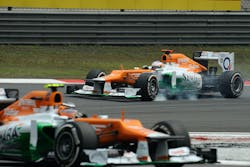Rosberg hits the top again on Pirelli P Zero yellow soft
Mercedes driver Nico Rosberg carried on where he had left off, following his pole position and debut victory in China last week, by setting the fastest time of the day during free practice in Bahrain. Rosberg set his fastest time of 1m32.816s on the P Zero Yellow soft tire during the second free practice session, which was characterized by high track temperatures. The P Zero White medium tire has also been nominated for Bahrain.
The Sakhir circuit reverted to the original layout that had last been used in 2009, before a longer loop was added for the 2010 race between turns four and five. This gives the circuit a faster and more flowing configuration, with 15 corners as opposed to 23, which puts the emphasis on traction as well as the front-left tire in particular.
A typical hallmark of Bahrain is the sand that blows onto the track from the surrounding desert, and this was very much in evidence during the first free practice session this morning: although to a lesser extent than many of the teams had anticipated. The effect of the dust is to make the cars slide more, which increases thermal degradation and slows down the lap time. McLaren driver Lewis Hamilton set a fastest time of 1m33.572s in the middle of the hour and a half morning session, using the Pirelli P Zero White medium tires. The Force India team was the only team to use the P Zero Yellow soft tires in the morning, placing third with Paul di Resta and sixth with Nico Hulkenberg.
Temperatures climbed progressively during the day, with the second free practice session in the afternoon starting with 31 degrees centigrade of ambient temperature and 40 degrees track temperature. As the session went on the track temperature fell again after reaching a peak, when Rosberg set his fastest time. These are the conditions that are likely for qualifying and the race, meaning that all the teams ran both compounds extensively during free practice two in order to accumulate as much data as possible.
Williams driver Pastor Maldonado was the first to switch onto the P Zero Yellow soft tires, 20 minutes into the second session, followed progressively by the other runners. With half an hour to go, many teams concentrated on long runs with high fuel: some splitting the work by running one car on soft tires and the other on medium tires, to cover every possibility.
Rosberg once again demonstrated his ability to get the most out of his P Zero tires at the peak of their working range, setting a fastest time that was nearly half a second faster than the next-quickest driver, Red Bull’s Mark Webber.
Pirelli’s motorsport director Paul Hembery said: “The sand on the track – a phenomenon that we are well aware of, following our tests in Bahrain in the past – limited the useful running in the morning, but it was a much busier session in the afternoon with all the teams running both compounds in order to make up for any lost time earlier. The teams will all have been looking closely at the effect of track temperature on performance, which is going to form an integral part of their strategy for qualifying and the race, as well as monitoring degradation. From what we can see so far the pace of both compounds is around 0.6 seconds apart and degradation is in line with expectations. But we still have a lot of data to go through tonight before we can accurately predict how long the stints are likely to be on each tire, as this is the first time that we are here in race conditions.”
PIRELLI FACT OF THE DAY:
Hot races and fast circuits may appear to push the P Zero tires to their limits, but the tires are actually subjected to much greater loads during laboratory testing. The tires are accelerated up to 450kph, submitted to vertical forces in excess of 1000 kilograms, heated up to 150 degrees centigrade and fired into kerbs at 260kph. These energy loads are all around four times greater than what can be realistically expected, and the tires are subjected to them for up to 20 times longer than they would normally.
